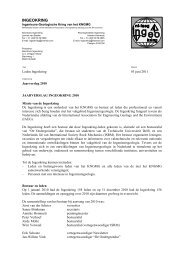News letter Dam edition
News letter Dam edition
News letter Dam edition
- No tags were found...
Create successful ePaper yourself
Turn your PDF publications into a flip-book with our unique Google optimized e-Paper software.
Ingeokring <strong>News</strong><strong>letter</strong><br />
Moraine dams and glacier lake outburst floods (GLOF)<br />
Senta Modder, DG Water, Ministerie Verkeer en Waterstaat<br />
Increased melting of glaciers due to climate change<br />
Climate change has its impacts on biodiversity, freshwater<br />
resources and local livelihoods. A rising average global temperature<br />
is threatening fragile ecosystems like glaciers. Seventy<br />
percent of the world’s freshwater is frozen in glaciers.<br />
Glacier melt buffers other ecosystems against climate variability.<br />
Very often it provides the only source of water for<br />
humans and biodiversity during dry seasons (IPCC, 2007).<br />
The Himalayas have the largest concentration of glaciers<br />
outside the polar caps. With glacier coverage of 33 000 km 2 ,<br />
the region is aptly called the ‘Water Tower of Asia’ as it provides<br />
around 8.6 million m 3 of water annually. These Himalayan<br />
glaciers feed seven of Asia’s great rivers and ensure a<br />
year round water supply to millions of people. Climate<br />
change has impacted the glacial ecosystem tremendously.<br />
67% of the glaciers in the Himalayas are retreating at a startling<br />
rate and the major causal factor has been identified as<br />
climate change (UNEP & ICIMOD, 2002).<br />
Increased risk of GLOF’s due to melting glaciers<br />
Many mountain glaciers in the world built up a prominent<br />
end-moraine during the Little Ice Age (Neo-Glacial) which<br />
lasted until approximately 1850. Since then, the majority of<br />
mountain glaciers in the world has been thinning and retreating<br />
upon a gradual change in climate. During retreat, a<br />
basin is usually formed between the thinning and receding<br />
ice-front and the end moraines. If the morainic dam is relatively<br />
impervious, a lake may form (Mool & Kadota, 1993).<br />
The material of an end moraine consists of unconsolidated<br />
moraine material and/or ice. Moraine material in general is<br />
composed of a diamicton, a heterogeneous mixture of boulders,<br />
gravel, sand and silt. Opposed to most man-made<br />
dams, which are constructed of reasonably erosion resistant<br />
material, the materials of a natural dam are generally very<br />
susceptible to erosion by piping and fluvial overflow. Glacial<br />
lake outburst floods (GLOF’s) are catastrophic discharges of<br />
water resulting primarily from melting glaciers. Principally, a<br />
moraine dam may break by the action of some external trigger<br />
or self-destruction. A huge displacement wave generated<br />
by rockslide or a snow/ice avalanche from the glacier<br />
terminus into the lake may cause the water to top the moraines<br />
and create a large breach that eventually causes dam<br />
failure (Ives, 1986). Earthquakes may also be one of the factors<br />
triggering dam break depending upon magnitude, location<br />
and characteristics. Self-destruction is a result of the<br />
failure of the dam slope and seepage from the natural drainage<br />
network of the dam or melting of internal ice cores.<br />
GLOF waves comprise water mixed with morainic materials<br />
and cause devastation for downstream riparian communities,<br />
hydropower stations and other infrastructure. In South<br />
Asia, particularly in the Himalayan region, it has been observed<br />
that the frequency of the occurrence of GLOF events<br />
has increased in the second half of the 20th century. GLOF’s<br />
have cost lives, property and infrastructure in India, Nepal<br />
and China.<br />
Fig. 1 Small GLOF at Chubung Glacier (Nepal) in 1991 (Modder & Van<br />
Olden, 1995).<br />
<strong>Dam</strong> <strong>edition</strong> | Double Issue 2007/2008 | 18




